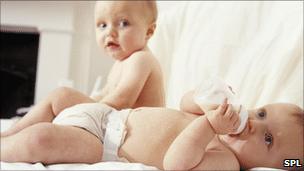IVF multiple births 'coming down' says HFEA
- Published

The HFEA wants to reduce the percentage of IVF births resulting in more than one child.
The proportion of risky multiple births during IVF treatment is falling according to the Human Fertilisation and Embryology Authority (HFEA).
Multiple birth pregnancies have a higher chance of miscarriage, and of leading to premature birth and of babies with cerebral palsy.
The HFEA said 23.6% of IVF births led to more than one child at the beginning of 2008, which fell to 22% in mid 2009.
The Multiple Births Foundation said it was "great news".
Multiple births are a consequence of increasing the odds of IVF working. Implanting more embryos increases the chance of success, but also the chance of twins or triplets.
The HFEA has introduced targets for reducing multiple births because of the health concerns for mother and child.
It has aimed for fewer than 24% IVF births resulting in more than one child by April 2010, 20% by April 2011 and 15% by April 2012.
One by one
Multiple births have health risks for the babies and the mother.
The reduction so far has largely been down to increased use of a technique called single embryo transfer.
Only one embryo is implanted in women who have the greatest chance of getting pregnant. HFEA figures show this has not affected the success rate.
Professor Lisa Jardine, chair of the HFEA said: "It is excellent news that the number of multiple births is coming down whilst overall success rates for patients are still being maintained. This shows that the policy is proving successful."
Susan Seenan, from the Infertility Network UK, said: "With full funding on the NHS - if patients could access three cycles - a lot more women would be willing and able to go for single embryo transfer.
"Some women who are only getting one cycle feel they are limiting their chances of success."
Jane Denton, director of the Multiple Births Foundation said: "There is no doubt that a multiple pregnancy creates risks for both mother and babies. The good news is that the strategy is working."
- Published8 November 2010